 small ship adventure cruises®
small ship adventure cruises® small ship adventure cruises®
small ship adventure cruises®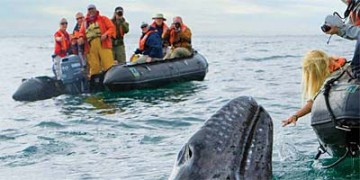
We embarked from La Paz, sailing in smooth water and enjoying great weather.
This morning with the first morning light, we could see Del Carmen Island on the west and Santa Catalina towards the east. The entire area has been experiencing unusually frequent rains. As evidence of such events, the sky was still wearing the majestic cumulus clouds that combined with the morning light, made is display an unusual beauty.
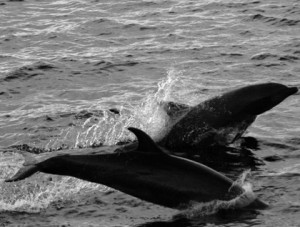 We took advantage of time spent on deck, and suddenly the ship was surrounded by bottlenose dolphins. These marine mammals are extremely intelligent and one of the qualities of smart creatures is play. And so, the dolphins approached the bow of our ship to ride it with joy. This was a widespread group, since we could see dolphins under our bow and also far away into the horizon.
We took advantage of time spent on deck, and suddenly the ship was surrounded by bottlenose dolphins. These marine mammals are extremely intelligent and one of the qualities of smart creatures is play. And so, the dolphins approached the bow of our ship to ride it with joy. This was a widespread group, since we could see dolphins under our bow and also far away into the horizon.
We sailed east towards one of the Gulf of California’s biological jewels; Isla Santa Catalina. We had the opportunity of exploring not only the island, but to submerge ourselves into the surrounding waters. Snorkelers plunged into the Gulf for the first time. The water temperature was warmer than we had predicted, and the visibility was quite good. Propelling ourselves with our colorful fins, we admired the rocky bottom, home to a wide array of fish and invertebrates. Some examples of the fish we saw today were king angels, sergeant majors, porcupine fish, and giant hawk fish. Different kinds of damselfishes were also seen, like the giant and Cortez damsels. These two species are not necessarily stunning to the eye as adults, but we found some of the electric-blue colored juveniles that really stand out from the rest.
Exploring Santa Catalina by foot is a real treat. After the rains the desert looks peaceful and content. This dot of land surrounded by sea is home to the unique giant barrel cactus and to a number of reptiles that exist nowhere else in the world. What a privilege to be able to explore these remote and almost untouched landscapes!
The officers of National Geographic Sea Bird pulled anchor before dawn, and we made way for morning activities on the Baja Peninsula. A following swell rolled toward us from the north as the early light broke through a broken cloud layer. Wrap-around swells affected many of the anchorages along the peninsula, so we headed south to the San Jose Channel instead. A group of over 12 short-finned pilot whales swam along with us for a few minutes and later disappeared amongst the whitecaps. This coastline is especially wild. The highway down Baja California is on the Pacific side so few people live in this region. The sun rose above of the clouds and cast pools of golden light on the spectacular Sierra de la Giganta and sandstone shoreline.
Alberto enlightened us with a program entitled Mexico Lindo, about the colorful and fascinating Mexican culture. More pilot whales made another appearance before we anchored for our morning walks.
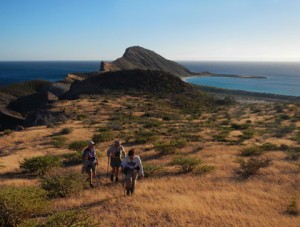 Our land-based outing was on Isla San Jose at Encantada, a protected anchorage within the San Jose Channel. Most of us walked up a beautiful, wide arroyo on sandy patterns from recent stream flows. This was the first canyon we’d been in with trees. Ironwood and palo verdes added a more somber backdrop for the striking white bark of palo blancos. The rains from past weeks had encouraged the lush greens from desert plants. Bright reds of coral vines added accents. Malva Rosa flowers were feeding an array of butterflies. Several large dark moths called black witches flew about, and many more littered the ground. Those guests on longer hikes made it to a sinuous narrow canyon that had been cut into sedimentary rock.
Our land-based outing was on Isla San Jose at Encantada, a protected anchorage within the San Jose Channel. Most of us walked up a beautiful, wide arroyo on sandy patterns from recent stream flows. This was the first canyon we’d been in with trees. Ironwood and palo verdes added a more somber backdrop for the striking white bark of palo blancos. The rains from past weeks had encouraged the lush greens from desert plants. Bright reds of coral vines added accents. Malva Rosa flowers were feeding an array of butterflies. Several large dark moths called black witches flew about, and many more littered the ground. Those guests on longer hikes made it to a sinuous narrow canyon that had been cut into sedimentary rock.
Later, while cruising on to Isla San Francisco we had a brief view of at least 100 long-beaked common dolphins. They quickly disappeared into the whitecaps of our following sea. Once on the beach, we became immersed in activities. One group walked to the other side of the island with Dr. William Gilly, an oceanographer working with National Geographic. They found many intertidal invertebrates including several species of nudibranchs and many brittle stars. Others snorkeled, kayaked, and hiked. Today’s expedition photo is of a group on its way to a rocky high point with great views of the island below. The south end of Isla San Francisco’s crescent beach can be seen in the background.
As the sun set, we ate a barbeque dinner on the beach. Our chef had prepared barbecued pulled pork and a fish named jurel. Our naturalists told Mexican stories, played the guitar, and gave an informal talk about stars and constellations. This day had been especially full, and most of our guests retired early.
At first light National Geographic Sea Bird pulled anchor and ventured out into the Canal San Jose, bordered to the west by the Baja peninsula and Isla San Jose to the east. As the sun rose, we could not only feel but also confirm by sight that Mother Nature had turned off her wind machine overnight as we sat quietly at anchor in the lee of the island. How lucky we were to be able to continue our voyage by turning north once again.
It’s hard to believe that it was the same piece of water that we had transited just the day prior when the sea was running 6 to 8 feet before a powerful El Norte or northerly wind. But now in the early hours of morning, our ship of exploration slipped gently through the much calmer, azure blue waters.
Enroute to our intended destination of Isla Danzante, we were treated to a very special photo interpretation, Among Giants, presented by Flip Nicklin our special guest from National Geographic. He is widely regarded as the world’s leading photographer of cetacea (whales, dolphins, and porpoises). And almost as if they knew Flip was aboard, a good sized pod of bottlenose dolphins raced over to ride our bow pressure wave; seemingly to see if he would snap their graceful images.
As our journey continued we were entranced by the sights of towering spires on the Baja peninsula along its backbone, the Sierra de la Giganta. Resulting from millions of years of volcanic activity later torn apart by further plate tectonic action that split Baja from mainland Mexico, the sierra is the defining geologic feature that can be seen for dozens of miles out in the Gulf of California, known to some as the Sea of Cortez.
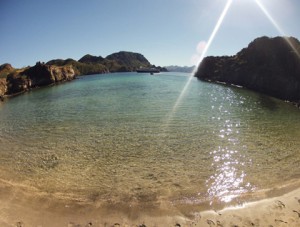 After lunch, we made our anchorage at Honeymoon Cove on the northwest corner of Isla Danzante. There could not be a more idyllic place to spend the afternoon hiking, kayaking, snorkeling, swimming, or marveling in the sights and sounds of this beautiful island. The birding was especially good with brown pelicans, cormorants, kingfishers, turkey vultures, and two dazzling ospreys perched on a nearby hillside cactus. Our undersea specialist brought back amazing images from below the surface for evening Recap, so that even those of us who stayed dry could see the vast array of marine life that was below. A plankton tow was also performed; and by using our onboard video microscope, we could see the tiny organisms that create an amazingly rich soup of life near the bottom of the food chain.
After lunch, we made our anchorage at Honeymoon Cove on the northwest corner of Isla Danzante. There could not be a more idyllic place to spend the afternoon hiking, kayaking, snorkeling, swimming, or marveling in the sights and sounds of this beautiful island. The birding was especially good with brown pelicans, cormorants, kingfishers, turkey vultures, and two dazzling ospreys perched on a nearby hillside cactus. Our undersea specialist brought back amazing images from below the surface for evening Recap, so that even those of us who stayed dry could see the vast array of marine life that was below. A plankton tow was also performed; and by using our onboard video microscope, we could see the tiny organisms that create an amazingly rich soup of life near the bottom of the food chain.
This day that had started out like peeking under the lid of Pandora’s Box, turned out spectacularly well. As we sat at anchor through the evening hours the heavens treated us to display of thousands of stars, constellations, and brilliant planets overhead. Wow, what a day!
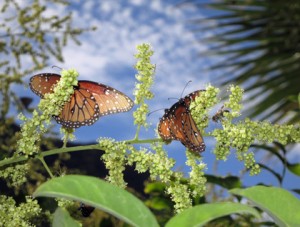
After a restful night in the immediate proximity of Puerto Escondido, behind the lovely island of Danzante, we started the engines and approached the dock at this small marina. Here we docked all day, while we did very interesting things: a van trip up into the mountains west of the small city of Loreto. The ride follows a small river in a ravine, most of the way paved, but with many landslides and parts of the highway washed out. Few places still offer us adventures like here in Baja California. Eventually we arrived at the location where the Jesuits founded the first chapel on the peninsula. As they were building it, they received orders to stop the construction of the church, and to go back down to the coast and build the church there first. This one was finished in 1702, and then they returned to the mountains and built the church there, which we see today, in a perfect state of conservation. We walked to the back of the church, where water gurgles constantly, and saw the place where the priests planted some food crops, as well as an enormous number of olive trees. Here we saw today the OLD ONE, with a trunk all gnarled by time, but still producing a good amount of olives. Among these olive trees are a big number of orange trees, as well as guava trees. Water runs everywhere! The reason for the church to have been built way up in the mountains was that this place was where the Guaycura natives were, because of all year water.
Around midday we were en route down the mountains, and arrived a while later in the small city of Loreto. We stopped at the mission of our Lady of Loreto, where we visited the old building, which is in perfect repair. We then walked to the hotel Mission, where we had a good lunch. The wind had begun blowing from the north, making the afternoon somewhat chilly. But we had a good time to visit the town and the handicraft shops. After this sojourn in Loreto, we were taken back to Puerto Escondido, where we boarded our ship and prepared for the Recap of today.
The north wind is blowing, but that is okay: we are headed south and today while we snuggle in at our anchorage at Ensenada Grande, the winds have bought us the luxury of time. This morning we made the most of a relaxed mosey and adopted the wandering amble. For some, the top of the arroyo and its magnificent view was their goal, for others, a leisurely stroll amongst the riotous blossoms and tangle of vegetation that has burst forth with the recent rains. Flowers galore carpet the desert floor as plants literally climb and clamber over one another. Whether to showcase blossoms for tempting passing pollinators, get a better perch for a bit more solar radiation or disperse seeds, the rambunctious botany stole the show. All colors of the rainbow are perched as petals on flowers, large and small. Gretchen found a lovely snake meandering along the arroyo, which cooperatively crossed the sand and was admired by a second group of our guests.
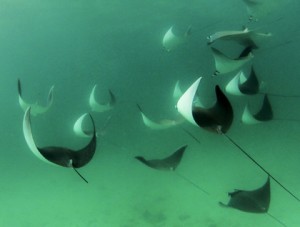 For the afternoon it was water sports and Zodiac cruises. A group of small rays cruised along the edge of the bay, and snorkelers made every effort to get a look at these underwater fliers. Gracefully flapping, the rays swam about the bay, while snorkelers paddled furiously in attempt to keep up. For those on the Zodiac cruises, they had their challenge of photographing flying rays. As the rays swam, some would periodically leap from the water in temporary flight, a visual treat as well as a photographic challenge all rolled up into one black and white potato chip. Brown pelicans slept or preened while perched along the sculpted cliffs of Isla Partida.
For the afternoon it was water sports and Zodiac cruises. A group of small rays cruised along the edge of the bay, and snorkelers made every effort to get a look at these underwater fliers. Gracefully flapping, the rays swam about the bay, while snorkelers paddled furiously in attempt to keep up. For those on the Zodiac cruises, they had their challenge of photographing flying rays. As the rays swam, some would periodically leap from the water in temporary flight, a visual treat as well as a photographic challenge all rolled up into one black and white potato chip. Brown pelicans slept or preened while perched along the sculpted cliffs of Isla Partida.
As the sun descended in the western sky, we finished up with our last Zodiac cruises, came inside for cocktails and appetizers in the lounge and the evening glowed with a blush of a sunset on the horizon.
A windy day brought us into the protection of this bay, and we took the time to immerse ourselves and revel in its beauty.
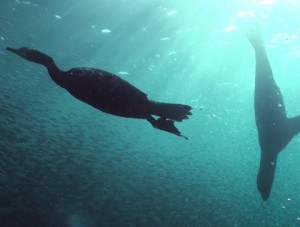
Just after sunrise the ship’s anchor dropped in the lee of Los Islotes, a tiny island where California sea lions cluster on pink volcanic rocks. Loud barks and wails reached the ship long before we climbed into Zodiacs for a chance to snorkel in the realm of these graceful creatures. Once in the water, curious youngsters born last summer came in for a close look at the strange creatures and rubber boats. King angelfish, leopard groupers, sergeant majors and even Brandt’s cormorants swam in the midst of their larger neighbors. Whenever a cormorant approached a school of fish, the small silvery shapes raced for their lives. These pelican relatives have large webbed feet that propel them as they search for their fishy prey. It was fascinating to watch all the activity in this undersea world.
After leaving Los Islotes, the ship headed south towards La Paz. The hotel staff provided a delicious ice-cream buffet on the top deck complete with all sorts of tasty toppings.
Once tied up at the dock, everyone scattered away with naturalists or on their own to explore this fascinating town. Some strode off to see the old church or joined our photo instructor for a stroll. Artistic sculptures and a bridal ensemble offered the perfect subject matter for photographic pursuits. As if our earlier ice cream feast were not enough, many stopped at La Fuente, a favorite ice cream store near the dock. Another option was a walk along the the malecón, the tiled path beside the waterfront. Egrets, ibises, and several species of sandpiper foraged along the shore. Local fishing boats known as pangas lay pulled up on the sand. In addition, there was some holiday flair, with Christmas ornaments decorating the street lamps and a brass band playing carols to those passing by.
Before dinner on this last night together in Baja California, we shared the group’s photos in the lounge. It was delightful to see the different images collected by so many who took part in this special voyage in the Sea of Cortez.
Tags: Baja California, baja mexico, cruise report, Sea of Cortez